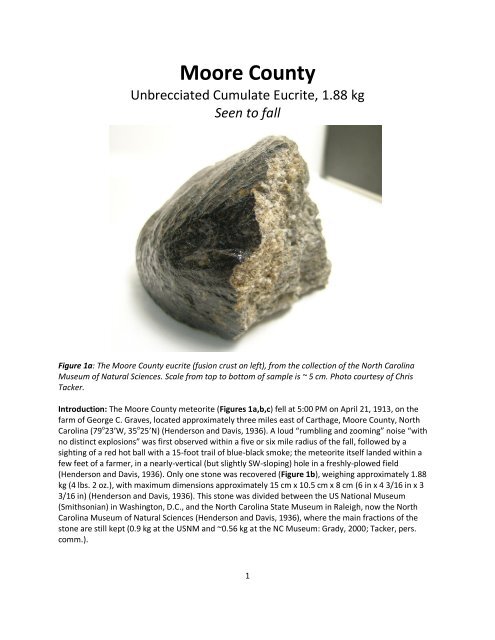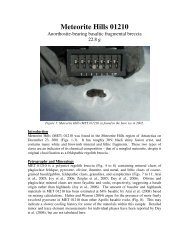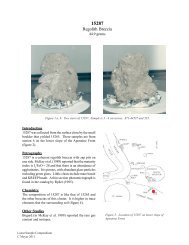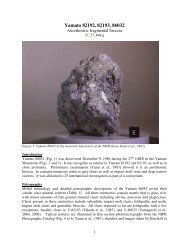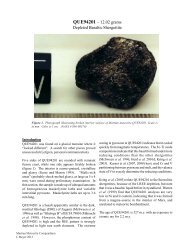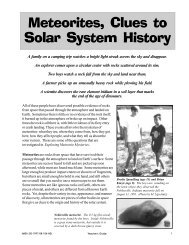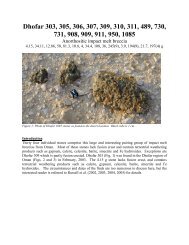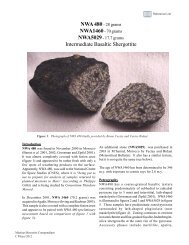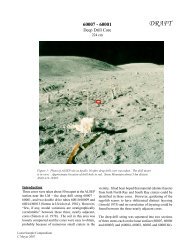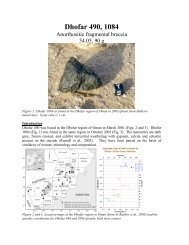Moore County Unbrecciated Cumulate Eucrite, 1.88 kg
Moore County Unbrecciated Cumulate Eucrite, 1.88 kg
Moore County Unbrecciated Cumulate Eucrite, 1.88 kg
Create successful ePaper yourself
Turn your PDF publications into a flip-book with our unique Google optimized e-Paper software.
<strong>Moore</strong> <strong>County</strong><br />
<strong>Unbrecciated</strong> <strong>Cumulate</strong> <strong>Eucrite</strong>, <strong>1.88</strong> <strong>kg</strong><br />
Seen to fall<br />
Figure 1a: The <strong>Moore</strong> <strong>County</strong> eucrite (fusion crust on left), from the collection of the North Carolina<br />
Museum of Natural Sciences. Scale from top to bottom of sample is ~ 5 cm. Photo courtesy of Chris<br />
Tacker.<br />
Introduction: The <strong>Moore</strong> <strong>County</strong> meteorite (Figures 1a,b,c) fell at 5:00 PM on April 21, 1913, on the<br />
farm of George C. Graves, located approximately three miles east of Carthage, <strong>Moore</strong> <strong>County</strong>, North<br />
Carolina (79 o 23’W, 35 o 25’N) (Henderson and Davis, 1936). A loud “rumbling and zooming” noise “with<br />
no distinct explosions” was first observed within a five or six mile radius of the fall, followed by a<br />
sighting of a red hot ball with a 15-foot trail of blue-black smoke; the meteorite itself landed within a<br />
few feet of a farmer, in a nearly-vertical (but slightly SW-sloping) hole in a freshly-plowed field<br />
(Henderson and Davis, 1936). Only one stone was recovered (Figure 1b), weighing approximately <strong>1.88</strong><br />
<strong>kg</strong> (4 lbs. 2 oz.), with maximum dimensions approximately 15 cm x 10.5 cm x 8 cm (6 in x 4 3/16 in x 3<br />
3/16 in) (Henderson and Davis, 1936). This stone was divided between the US National Museum<br />
(Smithsonian) in Washington, D.C., and the North Carolina State Museum in Raleigh, now the North<br />
Carolina Museum of Natural Sciences (Henderson and Davis, 1936), where the main fractions of the<br />
stone are still kept (0.9 <strong>kg</strong> at the USNM and ~0.56 <strong>kg</strong> at the NC Museum: Grady, 2000; Tacker, pers.<br />
comm.).<br />
1
<strong>Moore</strong> <strong>County</strong> is a flattened, conical-shaped (“shield”) meteorite with a dark brown, glossy fusion crust,<br />
well-developed flow lines and up to 4-mm deep regmaglypts. The fusion crust is 7 cm and a geocentric velocity of ≥6<br />
km/sec (Carver and Anders, 1976).<br />
<strong>Moore</strong> <strong>County</strong> is an unbrecciated cumulate eucrite, composed mostly of equigranular, uniformlydistributed,<br />
coarse-grained plagioclase and pyroxene. It is texturally and chemically similar to terrestrial<br />
cumulates, including evidence of crystal accumulation at the bottom of a magma chamber (Hess and<br />
Henderson, 1949). Chemically, it is more magnesian than non-cumulate eucrites, but it is the most ironrich<br />
cumulate eucrite.<br />
Figure 1b: The <strong>Moore</strong> <strong>County</strong> meteorite. This view is of the forward face with clear regmaglypts and flow<br />
lines. No scale is given for the photo, but maximum dimensions (at right angles) were reported as 15 cm<br />
x 10.5 cm x 8 cm (6 in x 4 3/16 in x 3 3/16 in). From Henderson and Davis (1936).<br />
General Petrography: The <strong>Moore</strong> <strong>County</strong> eucrite was first described by Henderson and Davis (1936),<br />
followed by Hess and Henderson (1949). These sources contain significant and detailed petrographic<br />
descriptions, as well as whole-rock and mineral chemistry data, and provide a good basic overview of<br />
the meteorite.<br />
2
<strong>Moore</strong> <strong>County</strong> is an unbrecciated, coarse-grained, equigranular to subophitic orthocumulate (Hsu and<br />
Crozaz, 1997) eucrite, consisting almost entirely of 0.5-1.5 mm, white to gray, subhedral to euhedral<br />
Figure 1c: Two different views of the <strong>Moore</strong> <strong>County</strong> eucrite (exterior – top, interior – left), from the<br />
collection of the North Carolina Museum of Natural Sciences. All photos courtesy of Chris Tacker at the<br />
NC Museum.<br />
laths of calcic plagioclase and 0.2-6 mm, brown-yellow, subhedral to euhedral crystals of ortho- and<br />
clinopyroxene (which also occur as inclusions and exsolution lamellae) uniformly distributed throughout<br />
the rock (Henderson and Davis, 1936; Hess and Henderson, 1949; Nord, 1983). Plagioclase is often<br />
included in pyroxene (Nord, 1983; Mittlefehldt, 1990) but pyroxene is never included in plagioclase<br />
(Nord, 1983). Henderson and Davis (1936) reported both plagioclase and pyroxene grains with welldeveloped<br />
cleavage faces; however, Hess and Henderson (1949) reported cleavage in pyroxene but not<br />
plagioclase.<br />
Tridymite is present as large, anhedral, interstitial grains; primary plagioclase and pyroxene grains<br />
abutting these large tridymite crystals have well-formed crystal faces, consistent with late tridymite<br />
formation from an intercumulus liquid trapped in pore spaces during crystal settling (Hess and<br />
Henderson, 1949; Nord, 1983, Mittlefehldt, 1990).<br />
Figure 2 shows a thin section photograph, and Figure 3 shows a drawing made from the same photo;<br />
both show basic textural and mineralogical relationships.<br />
Other accessory minerals in <strong>Moore</strong> <strong>County</strong> include opaques (ilmenite, chromite, troilite), and apatite,<br />
with some evidence of free metal; most of these minerals occur as interstitial grains (Hess and<br />
Henderson, 1949; Hostetler and Drake, 1978; Nord, 1983) and as inclusions in pyroxene or plagioclase<br />
(Henderson and Davis, 1936; Hess and Henderson, 1949; Hostetler and Drake, 1978). All component<br />
minerals are only loosely held together (i.e., weak intergranular bonding), and they can be easily<br />
separated by lightly rubbing a fresh surface of the rock, which complicated initial attempts to obtain a<br />
thin section (Henderson and Davis, 1936).<br />
3
Figure 3: Drawing of a<br />
portion of a <strong>Moore</strong> <strong>County</strong><br />
thin section, traced from<br />
the photograph in Figure 2,<br />
above. White = plagioclase,<br />
dotted gray = pyroxene<br />
(with (001) augite<br />
lamellae), black = opaque<br />
(mostly along boundaries<br />
between plagioclase and<br />
pyroxene). The gray areas<br />
in the upper left corner are<br />
interstitial tridymite. From<br />
Hess and Henderson<br />
(1949). The long dimension<br />
of the drawing is 1.2<br />
centimeters.<br />
4<br />
Figure 2: Thin section<br />
photomicrograph of<br />
<strong>Moore</strong> <strong>County</strong>, with<br />
dark pyroxenes, light<br />
plagioclase, and<br />
scattered opaques<br />
(tridymite is present as<br />
a dark gray interstitial<br />
phase but very hard to<br />
discern from<br />
pyroxene). Augite<br />
lamellae are parallel to<br />
(001) in pyroxenes. A<br />
0.2 mm-thick fusion<br />
crust with small<br />
bubbles can also be<br />
seen in the upper right<br />
hand corner. From<br />
Hess and Henderson<br />
(1949). No scale given.
Nord (1983) reported a 1-mm thick fine-grained zone of pyroxene and plagioclase traversing their entire<br />
thin section, with 0.2-0.5 mm crystals and a more granoblastic texture; this zone was found to be in<br />
optical continuity with the rest of the thin section, strongly suggesting its origin as a primary<br />
crystallization feature, possibly as a “nucleation burst” similar to those found in terrestrial cumulates.<br />
<strong>Moore</strong> <strong>County</strong> has a noticeable and quantifiable fabric, as the c-axes of primary pyroxene grains are in<br />
the same plane as the longer axes (b and c) of the plagioclase, resulting in a planar orientation for these<br />
crystals (Hess and Henderson, 1949; Figure 4). These observations are characteristic of plutonic<br />
cumulates, where crystals accumulate in nearly horizontal layers along the floor of the magma chamber,<br />
and thus these textures in <strong>Moore</strong> <strong>County</strong> indicate magmatic differentiation and crystal settling in an<br />
extraterrestrial setting (Hess and Henderson, 1949).<br />
Figure 4: Stereographs of pyroxene c-axes with respect to the plane of the thin section (left) and poles of<br />
the thin section with respect to plagioclase crystallographic axes (right). In the left diagram, C represents<br />
the center of the graph and is perpendicular to the thin section. In both cases, L represents the pole to<br />
the supposed plane of layering in <strong>Moore</strong> <strong>County</strong>. From Hess and Henderson (1949).<br />
Table 1 shows normative and modal mineralogy for <strong>Moore</strong> <strong>County</strong>. There is significant variability<br />
between the amounts of plagioclase and pyroxene in a number of the modes, and this is likely due to<br />
local heterogeneities within the meteorite, as well as the small areas counted by different authors for<br />
reported modes. Like the other cumulate eucrites, SiO2 contents in <strong>Moore</strong> <strong>County</strong> require an olivinenormative<br />
calculation, even though there is no olivine actually present (Mason et al, 1977).<br />
Pyroxene: Three different varieties of pyroxene (hypersthene and two pigeonites) were initially reported<br />
from mineral separates for <strong>Moore</strong> <strong>County</strong>; an exhaustive discussion of these pyroxenes can be found in<br />
Henderson and Davis (1936). More recent analyses have clarified at least four types with distinctly<br />
5
different chemical compositions (Hess and Henderson, 1949; Hostetler and Drake, 1978) and some<br />
researchers have reported even more (Mori and Takeda, 1981b).<br />
Table 1: Modal and normative mineralogy of <strong>Moore</strong> <strong>County</strong>.<br />
Reference Hess and Henderson 49 Prinz et al 80 Nord 83 Delaney et al 84e Kitts and Lodders 98 Mayne et al 09<br />
Type norm mode mode mode mode norm, wt % norm, vol % mode<br />
Pyroxene 50.13 56 36.7 37.4 36.7 54.8 49.7 52<br />
Plagioclase 44.54 40 58.5 55 61.1 41.8 48.5 44<br />
Ilmenite 0.61 -- 0.2 0.2 0.2 0.7 0.5 --<br />
Chromite 0.67 -- 0.5 0.2 0.4 0.6 0.4 --<br />
Tridymite 1.68 1.5 4.1 7.2 1 0.7 0.8 3<br />
Troilite 0.46 -- -- trace 0.6 -- -- --<br />
Apatite -- trace -- -- -- 0.1 0.1 --<br />
Metal 2.78 -- -- -- -- -- -- --<br />
Mineral Petrography and Chemistry:<br />
The main pyroxene phase in <strong>Moore</strong> <strong>County</strong> is pigeonite (Henderson and Davis, 1936; Hess and<br />
Henderson, 1949), with chemical compositions clustered around Ca6Mg47Fe47 and exhibiting an average<br />
Mg# of 51 (Hess and Henderson, 1949; Ishii and Takeda, 1974; Hostetler and Drake, 1978; Mori and<br />
Takeda, 1981b; Nord, 1983; Mittlefehldt, 1990; Mayne et al, 2009). These pigeonites have welldeveloped,<br />
coarse (25-100 µm) augite lamellae, with composition Ca41.5Mg36.8Fe21.7 – Ca43Mg36Fe21,<br />
parallel to (001) planes in the host pigeonite (Hess and Henderson, 1949; Ishii and Takeda, 1974;<br />
Miyamoto and Takeda, 1977; Takeda, 1979; Takeda et al, 1981; Mori et al, 1981; Mori and Takeda,<br />
1981b; Mayne et al, 2009; Figure 5). There are also finer (≤0.3 µm) lamellae of (001) augite, present<br />
between the coarse lamellae, with higher Ca and Mg contents (Takeda, 1973; Takeda, 1979; Takeda et<br />
al, 1981; Mori et al, 1981; Mori and Takeda, 1981b); these fine augite lamellae share a common c-axis<br />
with the host pigeonite, but the coarser augite lamellae are rotated approximately 1.5 o towards the a*axis<br />
from c* (Takeda, 1973). There is also twinning and cleavage within pigeonite (Takeda et al, 1983;<br />
Figure 5).<br />
A small amount of the pigeonite (20-30%: Nord, 1983) has inverted to orthopyroxene (Mg50Fe50 –<br />
Ca6Mg47Fe47: Hess and Henderson, 1949; Nord, 1983; Takeda et al, 1983), especially in small<br />
quadrilateral areas, bounded by pigeonite cleavages/twins and coarse augite lamellae, that cut through<br />
the fine augite lamellae (Hess and Henderson, 1949; Takeda et al, 1981; Mori et al, 1981; Mori and<br />
Takeda, 1981; Figure 5). This orthopyroxene, in turn, has very fine exsolution lamellae of high-Ca<br />
clinopyroxene (salite), with composition Ca50Mg32Fe18, parallel to (100) planes (Hess and Henderson,<br />
1949); alternatively, these lamellae could be finely chopped pieces of the fine augite lamellae that have<br />
elongated and formed short slabs of (100) augite, simulating (100) augite lamellae (Takeda et al, 1981;<br />
Mori and Takeda, 1981b). In some grains, pigeonite that has completely inverted to non-oriented<br />
orthopyroxene, with blebby (100) augites, coexists with partially inverted, oriented orthopyroxene<br />
(bounded by coarse (001) augite lamellae) (Mori and Takeda, 1981b; Takeda et al, 1983). Nord (1983)<br />
reported orthopyroxene that initially formed by an oriented reaction in one grain has continued across<br />
grain boundaries, transforming adjacent pigeonite grains by a non-oriented mechanism.<br />
6
Augite also occurs as 0.2-0.5 mm primary grains in <strong>Moore</strong> <strong>County</strong>, as well as epitaxial overgrowths on<br />
pigeonite (Nord, 1983). It probably formed later than pigeonite and plagioclase but before tridymite and<br />
chromite (Nord, 1983).<br />
Figure 5:<br />
Photomicrograph of<br />
partly inverted<br />
pigeonites from <strong>Moore</strong><br />
<strong>County</strong>; dark =<br />
orthopyroxene, light<br />
with small dark<br />
horizontal lamellae =<br />
pigeonite with twins<br />
and exposed cleavages,<br />
white = coarse (001)<br />
augite lamellae. Notice<br />
that the orthopyroxene<br />
is in small<br />
quadrilaterals bounded<br />
by coarse augite<br />
lamellae and pigeonite<br />
cleavages. From Takeda<br />
et al (1983).<br />
Two theories have been presented concerning the formation of different pyroxene phases in <strong>Moore</strong><br />
<strong>County</strong>, one by Hess and Henderson (1949) (also cited in Hostetler and Drake, 1978), and the other<br />
presented in Mori and Takeda (1981b). The first theory is shown in Figure 6. Bulk compositional data for<br />
all <strong>Moore</strong> <strong>County</strong> pyroxenes indicate that the original pyroxene phase was pigeonite, with composition<br />
Ca10Mg46Fe44; 12% of this original pigeonite was exsolved into the coarse (001) augite lamellae<br />
(Ca43Mg36Fe21), whereas the rest of the original pigeonite formed a second, less calcic pigeonite<br />
(Ca6Mg47Fe47), now the dominant pyroxene phase in <strong>Moore</strong> <strong>County</strong>. Some of this second pigeonite<br />
(~10%) inverted to a calcic hypersthene (opx) with similar composition to the host (Ca6Mg47Fe47), which<br />
then further exsolved calcium-rich (100) salite lamellae (Ca50Mg32Fe18). The rest of the inverted<br />
hypersthene formed a new hypersthene composition with little to no calcium (Mg50Fe50). Pigeonite<br />
Figure 6: The Hess and Henderson (1949) model of pyroxene exsolution and inversion in <strong>Moore</strong> <strong>County</strong>;<br />
see text for discussion.<br />
7
inversion to hypersthene could theoretically have occurred at the same time as the original augite<br />
exsolution, but the fact that the inversion was incomplete suggests that it occurred at lower<br />
temperatures than exsolution (Hess and Henderson, 1949; Hostetler and Drake, 1978).<br />
One shortcoming of the Hess and Henderson (1949) theory is that it is lacking an explanation for the fine<br />
(001) augite lamellae as described by many later workers (e.g., Takeda, 1973; Takeda, 1979; Takeda et<br />
al, 1981; Mori et al, 1981; Mori and Takeda, 1981b). An alternative (and perhaps more comprehensive)<br />
theory is presented in Mori and Takeda (1981b), shown in Figure 7. Similar to the Hess and Henderson<br />
(1949) theory, the original pigeonite in <strong>Moore</strong> <strong>County</strong> (Ca10Mg46Fe44) likely exsolved the coarse (001)<br />
augite lamellae (Ca41Mg35Fe24), while the rest of the original pigeonite formed a less-calcic composition<br />
(Ca6Mg47Fe47). A small amount of this new pigeonite then decomposed to non-oriented orthopyroxene<br />
with blebby augites, while the rest of the pigeonite exsolved new, fine (001) augite lamellae<br />
(Ca43Mg37Fe20) and formed an even less calcic clinopyroxene (Ca3Mg35Fe52), which is now the dominant<br />
pyroxene phase in the rock. A small amount of this final clinopyroxene partially inverted to oriented<br />
orthopyroxene with fine (100) augite or salite lamellae (which, as stated above, could be elongated and<br />
rotated (001) augite lamellae from the host).<br />
8<br />
Figure 7: The Mori and Takeda<br />
(1981b) model of pyroxene<br />
exsolution, decomposition, and<br />
inversion in <strong>Moore</strong> <strong>County</strong>; see text<br />
for discussion.<br />
One question that may arise from<br />
this discussion is actual<br />
composition of the dominant<br />
pigeonite in <strong>Moore</strong> <strong>County</strong>.<br />
According to the Hess and<br />
Henderson (1949) model, and<br />
numerous chemical analyses (e.g.,<br />
Hostetler and Drake, 1978; Nord,<br />
1983), it is close to Ca6Mg47Fe47,<br />
while the Mori and Takeda (1981b)<br />
model suggests that it is less calcic<br />
(Ca3Mg35Fe52). A clue to this<br />
discrepancy is found in Takeda et al<br />
(1981) and Mori and Takeda<br />
(1981b), who used ATEM (analytical<br />
transmission electron microscopy)<br />
to determine chemical compositions of the different pyroxenes; the bulk composition of the pyroxene in<br />
between the coarse (001) augite lamellae has approximately 6% by weight Ca (i.e., Hess and Henderson,<br />
1949), but this is probably due to low-Ca pigeonite or “clino-hypersthene” (Ca3Mg35Fe52: Mori and<br />
Takeda, 1981b) coexisting with high-Ca, fine augite lamellae (Ca43Mg37Fe20).
There are no other known cumulate or non-cumulate eucrites that display the same “intricate<br />
complexity” inherent to <strong>Moore</strong> <strong>County</strong> pyroxenes, but similar, partially-inverted pigeonites with augite<br />
exsolution lamellae are found in other observed falls and Antarctic meteorites. Hence, any pyroxene<br />
clasts with partial to total pigeonite inversion and (001) augite lamellae up to 20 µm wide are described<br />
as “<strong>Moore</strong> <strong>County</strong>-type” pyroxenes (Delaney et al, 1984e).<br />
Inclusions of euhedral to subhedral plagioclase (Nord, 1983; Mittlefehldt, 1990; Figure 8) and euhedral<br />
tridymite (Mittlefehldt, 1990) are found in <strong>Moore</strong> <strong>County</strong> pyroxenes, usually at the margins of the<br />
grains, especially where they abut interstitial tridymite (Mittlefehldt, 1990). The included plagioclase<br />
grains are of similar composition to larger plagioclase grains, and thus probably represent plagioclase<br />
nuclei that were trapped in growing pyroxenes (Mittlefelhdt, 1990). There is some evidence of small<br />
metal droplets along fractures in pyroxene (Hess and Henderson, 1949).<br />
Figure 8: Inverted BSE micrograph of <strong>Moore</strong> <strong>County</strong>. Plagioclase is light gray, tridymite is white, opaques<br />
are black, open cracks are white, and filled cracks are black; the light gray rectangular lines in the dark<br />
gray pigeonite host are coarse augite lamellae. Note the subhedral plagioclase inclusion (center, circled)<br />
located near where pyroxene abuts interstitial tridymite. From Mittlefehldt (1990).<br />
Pyroxene REE patterns show general increases in chondritic enrichment from LREE to HREE with a very<br />
sizeable europium deficiency (Schnetzler and Philpotts, 1969; Hsu and Crozaz, 1997; Figure 9), perhaps<br />
due to post-accumulation competition between pyroxene and plagioclase for these elements<br />
(Schnetzler and Philpotts, 1969). This competition did not greatly affect the pyroxene REE pattern<br />
outside of Eu (Schnetzler and Philpotts, 1969), but it may suggest that these crystals are zoned (Allen<br />
and Mason, 1973), though this latter contention is unsupported by chemical data.<br />
Additional, more recently published chemical data for <strong>Moore</strong> <strong>County</strong> pyroxenes can be found in<br />
Mittlefehldt (1990), Miyamoto and Takeda (1992, 1994), Pun and Papike (1995) and Hsu and Crozaz<br />
(1997). A discussion of the thermal and metamorphic history that produced the wide array of pyroxene<br />
compositions and textures seen in <strong>Moore</strong> <strong>County</strong> can be found in the Metamorphism section, below.<br />
9
Plagioclase: <strong>Moore</strong> <strong>County</strong> plagioclase occurs primarily as large grains dispersed throughout the<br />
meteorite (Henderson and Davis, 1936; Hess and Henderson, 1949), but also as minute euhedral<br />
inclusions in pyroxene (Figure 8), both with similar compositions (Mittlefehldt, 1990). Henderson and<br />
Figure 9: Rare-earth element patterns in <strong>Moore</strong> <strong>County</strong> pyroxenes; graphs from Schnetzler and Philpotts<br />
(1969) (top) and Hsu and Crozaz (1997) (bottom).<br />
Davis (1936) originally reported strongly cleaved plagioclase in their analysis of <strong>Moore</strong> <strong>County</strong> mineral<br />
separates, but this is contradicted by a lack of plagioclase cleavage found in the first thin section analysis<br />
(Hess and Henderson, 1949). These initially-reported cleavages may be curved, conchoidal fracture<br />
planes (Hess and Henderson, 1949) that were not immediately obvious from macroscopic observations.<br />
Numerous chemical analyses (e.g., Henderson and Davis, 1936; Duke and Silver, 1967; Hostetler and<br />
Drake, 1978; Tagai et al, 1994; Pun et al, 1997; Mayne et al, 2009) give a range of compositions from<br />
An89-An93. Al/Si ordering was attained in the tetrahedral sites ~94% (Tagai et al, 1994). There is no<br />
observable zoning (Hess and Henderson, 1949; Hostetler and Drake, 1978) but some crystals show latestage<br />
alteration to less calcic plagioclase (Hess and Henderson, 1949). Plagioclase in <strong>Moore</strong> <strong>County</strong> is the<br />
least calcic among the cumulate eucrites (Tera et al, 1997).<br />
Plagioclase twins are predominantly of albite, pericline, and manebach varieties, with no reported<br />
Carlsbad twinning (Hess and Henderson, 1949).<br />
The larger plagioclase grains contain numerous minute inclusions (Henderson and Davis, 1936). These<br />
include (1) minute blebs and spherical particles of metal along fracture planes (Hess and Henderson,<br />
1949), (2) faintly pink, Fe-rich isotropic, translucent crystals with an index of refraction between feldspar<br />
and tridymite (Hess and Henderson, 1949; Hostetler and Drake, 1978), (3) elongated, rhombohedral,<br />
brownish-red crystals (Henderson and Davis, 1936), (4) spherical reddish crystals (Henderson and Davis,<br />
1936), and (5) slender, uniform, prismatic crystals arranged in rows along cleavage (Henderson and<br />
Davis, 1936). None of these inclusions have been analyzed chemically or mineralogically by more recent<br />
authors.<br />
10
REE patterns in <strong>Moore</strong> <strong>County</strong> plagioclase indicate a decrease in enrichment from LREE to HREE, with a<br />
very large positive europium anomaly (Schnetzler and Philpotts, 1969; Hsu and Crozaz, 1997; Figure 10).<br />
This pattern indicates that the plagioclase was not in equilibrium with the same melt that crystallized<br />
pyroxene, and seems to suggest post-accumulation competition between pyroxene and plagioclase<br />
during slow cooling (Schnetzler and Philpotts, 1969; Allen and Mason, 1973). While the pyroxene REE<br />
patterns were not seriously affected by this incomplete re-equilibration, subtraction of REEs from<br />
plagioclase (especially HREE) affected its REE patterns significantly, as plagioclase initially had about<br />
one-third the concentration of these elements compared to pyroxene (Schnetzler and Philpotts, 1969).<br />
<strong>Moore</strong> <strong>County</strong> plagioclase has often been used for comparison in Rb-Sr studies of lunar and meteoritic<br />
materials (Papanastassiou and Wasserburg, 1972; Wasserburg et al, 1977; Wooden et al, 1981;<br />
Nakamura et al, 1985), as the calculated initial 87 Sr/ 86 Sr total rock (0.69908) and plagioclase values<br />
(0.69898) for <strong>Moore</strong> <strong>County</strong> (Papanastassiou and Wasserburg, 1972) are very close to the calculated<br />
initial 87 Sr/ 86 Sr for the parent body of basaltic achondrites (0.698990: Papanastassiou and Wasserburg,<br />
1969).<br />
Figure 10: Rare-earth element patterns in <strong>Moore</strong> <strong>County</strong> plagioclase; graphs from Schnetzler and<br />
Philpotts (1969) (top – modified to show <strong>Moore</strong> <strong>County</strong> data in red) and Hsu and Crozaz (1997) (bottom).<br />
Ilmenite: Ilmenite is found in <strong>Moore</strong> <strong>County</strong> in well-developed, 0.15-0.3 mm crystals (1) in association<br />
with chromite, usually surrounded by tridymite (Nord, 1983), or (2) on or near plagioclase-pyroxene<br />
boundaries (Hess and Henderson, 1949), suggesting a late-phase origin. Ilmenite grains are anisotropic,<br />
pleochroic, and likely represent ilmenite-magnetite solid solution (Hess and Henderson, 1949). In cases<br />
where it appears with chromite it is separated by sharp, straight boundaries (Hess and Henderson, 1949)<br />
which are probably minute fractures (Hostetler and Drake, 1978). Chemical analyses of <strong>Moore</strong> <strong>County</strong><br />
ilmenite indicate an Mg# = 5-8 (Bunch and Keil, 1971; Hostetler and Drake, 1978; Mayne et al, 2009) and<br />
FeO/MnO = 49-52 (Bunch and Keil, 1971; Mayne et al, 2009). No zoning was observed in <strong>Moore</strong> <strong>County</strong><br />
ilmenites (Hostetler and Drake, 1978).<br />
Chromite: Chromite occurs in <strong>Moore</strong> <strong>County</strong> as well-developed, 0.15-0.3 mm crystals (1) in association<br />
with ilmenite surrounded by tridymite (Nord, 1983), (2) on or near plagioclase-pyroxene boundaries<br />
11
(Hess and Henderson, 1949), or (3) smaller grains included in pyroxene (Nord, 1983). These occurrences<br />
indicate chromite as a late-crystallizing phase (Nord, 1983). In cases where it appears with ilmenite it is<br />
separated by sharp, straight boundaries (Hess and Henderson, 1949) which are probably minute<br />
fractures (Hostetler and Drake, 1978). Chemical analyses of <strong>Moore</strong> <strong>County</strong> chromite indicate an Mg# =<br />
5-7 and a Cr# = 80-83 (Bunch and Keil, 1971; Hostetler and Drake, 1978; Mayne et al, 2009). No zoning<br />
was observed in <strong>Moore</strong> <strong>County</strong> chromites (Hostetler and Drake, 1978).<br />
Tridymite: Silica in <strong>Moore</strong> <strong>County</strong> was originally reported as quartz (Henderson and Davis, 1936), but<br />
later workers (e.g., Hess and Henderson, 1949; Duke and Silver, 1967; Hostetler and Drake, 1978; Nord,<br />
1983; Mittlefehldt, 1990) have all reported tridymite. It occurs mainly as large anhedral grains,<br />
interstitial to pyroxene and plagioclase (Hess and Henderson, 1949; see Figure 3 and discussion of<br />
petrography, above). Numerous minute, acicular crystals of apatite occur as inclusions, in addition to an<br />
unidentified pink isotropic mineral (also found in plagioclase) and minute opaque specks (Hess and<br />
Henderson, 1949). Tridymite itself also occurs as euhedral inclusions in the margins of pyroxene and<br />
plagioclase, most commonly where these minerals abut interstitial tridymite, further implying its origin<br />
as a late phase crystallized from trapped liquid (Mittlefehldt, 1990). Chemically, it is essentially pure SiO2<br />
with trace amounts of Al and Mg (Hostetler and Drake, 1978).<br />
Troilite: Troilite is present in <strong>Moore</strong> <strong>County</strong> as small, subhedral grains (Hostetler and Drake, 1978) and<br />
occurs similarly to ilmenite and chromite. Unlike many other HED achondrites, troilite occurrences are<br />
not associated with metal (Hostetler and Drake, 1978). A recent chemical analysis of <strong>Moore</strong> <strong>County</strong><br />
troilite showed mostly Fe and S with a trace amount of Ni (Mayne et al, 2009).<br />
Apatite: Apatite occurs in <strong>Moore</strong> <strong>County</strong> in two ways, as (1) sharp, well-formed, acicular crystals<br />
included in large interstitial tridymite grains (Hess and Henderson, 1949), and as (2) small inclusions in<br />
pyroxene grains (Delaney, 1982c). As these apatites make a significant contribution to the REE<br />
abundances in <strong>Moore</strong> <strong>County</strong>, it is likely that REE analyses of pyroxene are contaminated by included<br />
phosphates, as pyroxene/plagioclase REE ratios are much higher than modal ratios (e.g., Cepyx/Ceplag ≈ 4,<br />
whereas pyxmodal/plagmodal ≈ 1) (Delaney, 1982c). However, direct quantitative analysis of apatite in<br />
<strong>Moore</strong> <strong>County</strong> is inhibited by its small size (Hostetler and Drake, 1978).<br />
Metal: The only occurences of free metal in <strong>Moore</strong> <strong>County</strong> have been reported along curved, conchoidal<br />
fractures in plagioclase, and to a lesser extent in pyroxene as well (Hess and Henderson, 1949). They<br />
appear as tiny, barely visible blebs or spherical masses that transition to “minute specks”; their<br />
appearance as droplets rather than distinct crystals suggests that they are metallic iron, and their<br />
presence along fractures implies a younger formation age for the metal inclusions than the crystals they<br />
are included in (Hess and Henderson, 1949). A recent chemical analysis of <strong>Moore</strong> <strong>County</strong> metal shows<br />
that it is >99.5% Fe, with less than 1% Co and trace amounts of Ni and P (Mayne et al, 2009).<br />
Whole Rock Composition: The major element chemistry of <strong>Moore</strong> <strong>County</strong> is shown in Table 2, followed<br />
by minor and trace element data in Table 3. Mg# (MgO/(MgO+FeO)) is also reported for whole rock<br />
values, as <strong>Moore</strong> <strong>County</strong> is more iron-rich (and calcium-rich) than most other cumulate eucrites<br />
(Mittlefehldt, 1990; Pun and Papike, 1995) but more magnesium-rich than most non-cumulate eucrites<br />
(e.g., Stannern, Nuevo Laredo, and Juvinas), as observed especially well in pyroxene chemistry (Figure<br />
11).<br />
12
13<br />
Figure 11: Pyroxene<br />
quadrilaterals showing<br />
<strong>Moore</strong> <strong>County</strong> in relation<br />
to other cumulate eucrites<br />
(as well as JV = Juvinas on<br />
the bottom diagram).<br />
<strong>Moore</strong> <strong>County</strong> is more Ferich<br />
than other cumulate eucrites (BD =<br />
Binda, MA = Moama) but more Mg-rich<br />
than the main group noncumulate eucrites.<br />
The top diagram shows corresponding host<br />
and lamellae compositions; the bottom<br />
diagram similar data connected by tie lines.<br />
Top diagram from Pun and Papike (1995),<br />
bottom from BVSP (1981).<br />
Figure 12: Chondritenormalized<br />
REE data<br />
(whole-rock) for the<br />
<strong>Moore</strong> <strong>County</strong> eucrite,<br />
showing generally flat<br />
but enriched REE<br />
patterns and a<br />
noticeable positive Eu<br />
anomaly. Reference<br />
chondrite (CI) is from<br />
Evensen et al (1978).
Duke and Silver (1967) plotted the bulk composition of <strong>Moore</strong> <strong>County</strong> on a normative MgSiO3-FeSiO3-<br />
CaAl2Si2O8 (enstatite-ferrosilite-anorthite) ternary diagram; whereas most eucrite bulk compositions plot<br />
near the pyroxene-plagioclase boundary curve (suggestive of coincident crystallization of pyroxene and<br />
plagioclase), <strong>Moore</strong> <strong>County</strong> falls within the anorthite stability field, and is thus termed a “feldsparcumulate”<br />
eucrite.<br />
Whole-rock REE data from Table 3 is plotted in Figure 12, normalized to chondritic values. REE patterns<br />
for <strong>Moore</strong> <strong>County</strong> show overall enrichment (4-6x) from chondritic values, with a slight increase from<br />
LREE to HREE enrichment and a noticeable positive Eu anomaly. These values are consistent with the<br />
cumulate, plagioclase-rich nature of <strong>Moore</strong> <strong>County</strong>.<br />
Mittlefehldt (1987) investigated volatile alkali contents in <strong>Moore</strong> <strong>County</strong> and other cumulate eucrites,<br />
and compared them to an average of normalized cosmic abundances of refractory elements in each<br />
sample (referred to as AHIR = average highly incompatible refractory). He found that AHIR increased<br />
among the feldspar-cumulate eucrites with increasing Fe content (consistent with fractionation from a<br />
single magma), but saw that K/AHIR and Rb/AHIR decreased with similar increases in Fe, suggesting<br />
volatile loss and degassing during magma cooling and crystallization. (As <strong>Moore</strong> <strong>County</strong> is the most Ferich<br />
cumulate eucrite, this suggests more volatile loss in <strong>Moore</strong> <strong>County</strong> relative to the other cumulates.)<br />
Radiogenic Isotopes: The first reported age date for <strong>Moore</strong> <strong>County</strong> was a K-Ar age of 3.23 ± ~0.2 Ga<br />
(Geiss and Hess, 1958), who posited that this age could represent crystallization or the last serious<br />
heating event experienced by the rock. This and other variable K-Ar ages (e.g., 3.5 Ga: Heymann et al,<br />
1968) suggest the likelihood of argon loss post-crystallization for <strong>Moore</strong> <strong>County</strong>. However, careful<br />
correction of argon isotopic character in <strong>Moore</strong> <strong>County</strong> can still provide important constraints on the<br />
crystallization and cooling history, as the most recently-obtained age (4.460 Ga: Shukolyukov and<br />
Begemann, 1996b) is coincident with other Sm-Nd and Lu-Hf age dates (see below).<br />
Other early ages for <strong>Moore</strong> <strong>County</strong> include Rb-Sr and Sr-Sr ages for HED achondrites as a whole (4.5 Ga:<br />
Gast, 1962; 4.39 ± 0.26 Ga: Papanastassiou and Wasserburg, 1969), as well as a (U,Th)- 4 He age, specific<br />
to <strong>Moore</strong> <strong>County</strong>, of 5.0 ± 0.2 Ga (Heymann et al, 1968). However, as noted by Carver and Anders<br />
(1976), <strong>Moore</strong> <strong>County</strong> has a significant 4 He excess (estimated at 580 x 10 -8 STP/g using 4.56 Ga as the<br />
crystallization age, or 14% of the total 4 He), and thus this (U, Th)- 4 He age does not have any significance<br />
to the history of the meteorite.<br />
14
Table 2: Major element data, and literature averages, for the <strong>Moore</strong> <strong>County</strong> eucrite.<br />
reference Hess and Henderson 49 Schmitt et al 72 Allen and Mason 73 McCarthy et al 73 Kitts and Lodders 98 Barrat et al 00 Mittlefehldt and Lindstrom 03 Average Literature Values<br />
recalc. from H&H, 49<br />
weight -- 226 mg -- -- -- 103.32 mg 63.73 mg --<br />
SiO2 48.16 -- 48.16 48.32 48.24 -- -- 48.22<br />
TiO2 0.32 -- 0.32 0.438 0.37 0.43 -- 0.38<br />
Al2O3 15.57 15.61 15.57 12.65 14.68 14.77 -- 14.81<br />
FeO 13.98 11.45 15.02 17.24 14.82 15.64 13 14.45<br />
Fe2O3 1.9 -- -- -- -- -- -- 1.9 (H&H 49 only)<br />
MnO 0.31 0.45 0.31 0.52 0.46 0.45 -- 0.42<br />
MgO 8.41 -- 8.41 9.41 9.04 8.54 -- 8.76<br />
CaO 11.08 -- 11.08 9.37 10.29 9.8 10.9 10.42<br />
Na2O 0.45 0.43 0.45 -- 0.44 0.45 0.471 0.45<br />
K2O 0.09 -- 0.09 0.02 0.02 -- 0.025 0.05<br />
Cr2O3 0.44 0.28 0.44 0.44 0.39 0.41 0.301 0.39<br />
P2O5 -- -- -- 0.036 0.036 -- -- 0.04<br />
S% 0.3 -- -- -- 0.33 -- -- 0.32<br />
FeS -- -- 0.82 -- -- -- -- 0.82<br />
sum (reported) 101.01 -- 100.67 -- -- -- -- --<br />
Mg# 52 -- 50 49 52 49 -- 52<br />
technique: wet chemistry INAA wet chemistry X-ray flour. spec. lit survey ICP-AES INAA --<br />
15
Table 3: Minor, trace, and REE data for <strong>Moore</strong> <strong>County</strong>.<br />
reference Reed and Jovanovic 69 Ahrens 70 Tera et al 70 Schmitt et al 72 Allen and Mason 73 Morgan et al 78 Mittlefehldt 87<br />
weight -- -- 182 mg 226 mg -- -- --<br />
Ca ppm -- -- 67500 (c) -- -- -- --<br />
Na ppm -- -- 2750 (e) -- -- 2920 (a) --<br />
K ppm -- -- 159 (c) -- -- -- 175 (a)<br />
P ppm -- -- -- -- -- -- 160 (a)<br />
Sc ppm -- 24 (a) -- 24 (b) 24 (a) 24 (a) --<br />
Ti ppm -- -- -- -- 2000 (a) -- --<br />
V ppm -- -- -- -- 70 (f) -- --<br />
Cr ppm -- -- -- -- 3000 (a) 1930 (a) --<br />
Mn ppm -- -- -- -- 2400 (a) -- --<br />
Co ppm -- -- -- 3 (b) 3 (a) 3 (a) --<br />
Ni ppm -- -- -- -- 16 (f) 3.5 (g) --<br />
Cu ppm -- -- -- 7 (b) 3 (a) -- --<br />
Zn ppm -- -- -- -- 11 (f) 1.2 (g) --<br />
Ga ppm -- -- -- -- 2 (f) -- --<br />
Ge ppm -- -- -- -- -- 0.0073 (g) --<br />
As ppb -- -- -- -- -- -- --<br />
Se ppm -- -- -- -- -- 0.5 (g) --<br />
Rb ppm -- -- 0.0497 (c) -- -- 0.03 (g) 0.055 (a)<br />
Sr ppm -- 79.5 (a) 64.1 (c) -- 70 (f) -- --<br />
Y ppm -- -- -- -- 9 (f) -- --<br />
Zr ppm -- -- -- -- 22 (f) -- --<br />
Nb ppm -- -- -- -- -- -- --<br />
Mo ppb -- -- -- -- -- -- --<br />
Ru ppm -- -- -- -- -- -- --<br />
Rh ppm -- -- -- -- -- -- --<br />
Pd ppb -- -- -- -- -- 0.4 (g) --<br />
Ag ppb -- -- -- -- -- 3.2 (g) --<br />
Cd ppb -- -- -- -- -- 7.1 (g) --<br />
In ppb -- -- -- -- -- -- --<br />
Sn ppb -- -- -- -- -- -- --<br />
Sb ppb -- -- -- -- -- 1.1 (g) --<br />
Te ppb 22.5 ± 7 (d) -- -- -- -- 4.1 (g) --<br />
Cs ppb -- -- 0.71 (c) Schnetzler and Philpotts 69 -- 0.7 (g) 0.70 (a)<br />
Ba ppm -- 21 (a) 18.6 (c) 22.5 (c) 21 (f) -- --<br />
La ppm -- -- -- -- 1.0 (f) -- --<br />
Ce ppm -- -- -- 3.08 (c) 3.0 (b) 3.1 (a) --<br />
Pr ppm -- -- -- -- 0.43 (f) -- --<br />
Nd ppm -- 2.81 (a) -- 2.81 (c) 2.81 (a) -- --<br />
Sm ppm -- -- -- 0.0938 (c) 0.938 (a) 0.9 (a) --<br />
Eu ppm -- -- -- 0.591 (c) 0.59 (a) 0.6 (a) --<br />
Gd ppm -- -- -- 1.22 (c) 1.22 (a) -- --<br />
Tb ppm -- -- -- -- -- -- --<br />
Dy ppm -- -- -- 1.62 (c) 1.62 (a) -- --<br />
Ho ppm -- -- -- -- -- -- --<br />
Er ppm -- -- -- 1.01 (c) 1.01 (a) -- --<br />
Tm ppm -- -- -- -- -- -- --<br />
Yb ppm -- 1.08 (a) -- 1.08 (c) 1.08 (a) 1.05 (a) --<br />
Lu ppm -- -- -- -- -- 0.2 (a) --<br />
Hf ppb -- -- -- -- -- 610 (a) --<br />
Ta ppb -- -- -- -- -- -- --<br />
W ppb -- -- -- -- -- -- --<br />
Re ppb -- -- -- -- -- 0.060 (a) --<br />
Os ppb -- -- -- -- -- 0.400 (a) --<br />
Ir ppb -- -- -- -- -- -- --<br />
Pt ppb -- -- -- -- -- -- --<br />
Au ppb -- -- -- -- -- 0.23 (g) --<br />
Th ppb -- 62 (a) -- Duke and Silver 67 -- -- --<br />
U ppb 14.4 (d) 30 (a) -- 19.6 (a) -- 48 (g) --<br />
Li ppm -- -- 2.95 (c) -- -- -- --<br />
B ppm -- -- -- -- -- -- Gibson et al 85<br />
S ppm -- -- -- -- -- -- 3375<br />
F ppm 91.5 ± 0.6 (d) -- -- -- -- -- --<br />
Cl ppm 5.7 ± 1.3 (d) -- -- -- -- -- --<br />
Br ppm 0.068 ± 0.017 (d) -- -- Kuroda et al 66 -- 0.014 (g) --<br />
I ppb -- -- -- 81 ± 8 (b) -- -- --<br />
Pb ppm -- -- -- -- -- -- --<br />
Hg ppb -- -- -- -- -- -- --<br />
Tl (ppb) -- -- -- -- -- 0.08 (g) --<br />
Bi (ppb) -- -- -- -- -- 0.36 (g) --<br />
technique: (a) lit survey, (b) INAA, (c) stable isotope dil. MS, (d) photon & neutron activation, (e) atomic absorption, (f) spark source MS, (g) RNAA, (h) ICP-MS<br />
16
Table 3 (cont.): Minor, trace, and REE data for <strong>Moore</strong> <strong>County</strong>.<br />
reference Paul and Lipschutz 90 Shukolyukov and Begemann 96a Kitts and Lodders 98 Barrat et al 00 Mittlefehldt and Lindstrom 03<br />
weight -- -- -- 103 mg 63.73 mg<br />
comments avg. of 2 samples no technique given -- -- --<br />
Ca ppm -- 72300 73500 (a) -- --<br />
Na ppm -- -- 3130 (a) -- --<br />
K ppm -- 180 191 (a) -- 210 (b)<br />
P ppm -- -- 157 (a) -- --<br />
Sc ppm -- -- 22.5 (a) 19.8 (h) 19.7 (b)<br />
Ti ppm -- -- 2194 (a) -- --<br />
V ppm -- -- 92 (a) -- --<br />
Cr ppm -- -- 2650 (a) -- --<br />
Mn ppm -- -- 3526 (a) -- --<br />
Co ppm 5.06 (b) -- 5 (a) 11.3 (h) 6.33 (b)<br />
Ni ppm -- -- 12 (a) 4.2 (h) --<br />
Cu ppm -- -- 5.5 (a) 6.0 (h) --<br />
Zn ppm 0.98 (b) -- 1.1 (a) 3.4 (h) --<br />
Ga ppm 1.65 (b) -- 1.8 (a) 1.60 (h) --<br />
Ge ppm -- -- 0.007 (a) -- --<br />
As ppb -- -- -- -- 150 (b)<br />
Se ppm 0.275 (b) -- 0.35 (a) -- --<br />
Rb ppm 0.046 (b) -- 0.06 (a) 0.06 (h) --<br />
Sr ppm -- 70.9 71 (a) 70 (h) 91 (b)<br />
Y ppm -- 9.5 9 (a) 10.29 (h) --<br />
Zr ppm -- 19 22 (a) 15.38 (h) --<br />
Nb ppm -- -- -- 0.57 (h) --<br />
Mo ppb -- -- -- -- --<br />
Ru ppm -- -- -- -- --<br />
Rh ppm -- -- -- -- --<br />
Pd ppb -- -- 0.4 (a) -- --<br />
Ag ppb 2.31 (b) -- 2.6 (a) -- --<br />
Cd ppb 17.2 (b) -- 12.2 (a) -- --<br />
In ppb 0.09 (b) -- 0.09 (a) -- --<br />
Sn ppb -- -- -- -- --<br />
Sb ppb 4.5 (b) -- 3.3 (a) -- 171 (b)<br />
Te ppb 2.5 (b) -- 3 (a) -- --<br />
Cs ppb 0.88 (b) -- 0.8 (a) 1 (h) --<br />
Ba ppm -- 22 26 (a) 20.6 (h) 33 (b)<br />
La ppm -- 1.14 1.160 (a) 1.28 (h) 1.16 (b)<br />
Ce ppm -- 2.93 3 (a) 3.38 (h) 3.2 (b)<br />
Pr ppm -- -- 0.430 (a) 0.521 (h) --<br />
Nd ppm -- 2.81 2.120 (a) 2.70 (h) --<br />
Sm ppm -- -- 0.886 (a) 0.906 (h) 0.705 (b)<br />
Eu ppm -- -- 0.570 (a) 0.527 (h) 0.598 (b)<br />
Gd ppm -- -- -- 1.26 (h) --<br />
Tb ppm -- -- -- 0.239 (h) 0.201 (b)<br />
Dy ppm -- -- -- 1.69 (h) --<br />
Ho ppm -- -- -- 0.376 (h) --<br />
Er ppm -- -- -- 1.10 (h) --<br />
Tm ppm -- -- -- -- --<br />
Yb ppm -- -- 1 (a) 1.04 (h) 1.01 (b)<br />
Lu ppm -- -- 0.2 (a) 0.160 (h) 0.139 (b)<br />
Hf ppb -- -- 610 (a) 530 (h) 460 (b)<br />
Ta ppb -- -- -- 30 (h) 36 (b)<br />
W ppb -- -- -- 18 (h) --<br />
Re ppb -- -- 0.041 (a) -- --<br />
Os ppb -- -- 0.003 (a) -- --<br />
Pt ppb -- -- -- -- --<br />
Au ppb 0.41 (b) -- 0.3 (a) -- 10.3 (b)<br />
Th ppb -- -- 62 (a) 125 (h) 51 (b)<br />
U ppb 8.6 (b) 30 27 (a) 64 (h) --<br />
S ppm -- -- 3300 (a) -- --<br />
F ppm -- -- 60 (a) -- --<br />
Cl ppm -- -- 5.65 (a) -- --<br />
Br ppm -- -- 0.05 (a) -- 0.230 (b)<br />
I ppb -- -- 135 (a) -- --<br />
Pb ppm -- -- 25 (a) -- --<br />
Hg ppb -- -- 2740 (a) -- --<br />
Tl (ppb) 0.070 (b) -- 0.08 (a) -- --<br />
Bi (ppb) 0.54 (b) -- 0.5 (a) -- --<br />
technique: (a) lit survey, (b) INAA, (c) stable isotope dil. MS, (d) photon & neutron activation, (e) atomic absorption, (f) spark source MS, (g) RNAA, (h) ICP-MS<br />
17
More recent <strong>Moore</strong> <strong>County</strong> age-dating work (i.e., post-1970) has focused primarily on Sm-Nd and Pb-Pb<br />
ages. Nakamura et al (1977) reported an internal isochron Sm-Nd age of 4.60 ± 0.04 Ga, which was later<br />
corrected by Nakamura and Tatsumoto (1980) to 4.54 ± 0.04 Ga based on an error in tracer calibration.<br />
Younger Sm-Nd ages of 4.457 ± 0.025 Ga and 4.456 ± 0.025 Ga (Figure 13) were obtained by Tera et al<br />
(1987b) and Tera et al (1997), respectively; a similar bulk eucrite Sm-Nd isochron of 4.464 ± 0.075 Ga<br />
and a cumulate eucrite Lu-Hf isochron of 4.470 ± 0.022 Ga were also obtained by Blichert-Toft et al<br />
(2002).<br />
18<br />
Figure 13: Sm-Nd isochron for<br />
<strong>Moore</strong> <strong>County</strong>, revealing a<br />
crystallization (or differentiation)<br />
age of 4.456 ± 0.025 Ga. From Tera<br />
et al (1997).<br />
Figure 14: Six-point Pb-Pb isochron<br />
for <strong>Moore</strong> <strong>County</strong>, revealing a Pb-Pb<br />
age of 4.484 ± 0.019 Ga. Samples<br />
were taken from >10 mm below the<br />
fusion crust to avoid contamination<br />
from terrestrial Pb. From Tera et al,<br />
1997.
These Sm-Nd and Lu-Hf ages are in contrast with initial <strong>Moore</strong> <strong>County</strong> Pb-Pb ages determined by Tera<br />
and other workers in multiple studies. Early results gave Pb-Pb ages of 4.55 Ga (Tera et al, 1987a); these<br />
results were affected by severe terrestrial Pb contamination similarly to other cumulate eucrites (Tera et<br />
al, 1987a; 1987b; 1997), but progressive leaching experiments suggested that the 4.55 Ga age was valid<br />
(Tera et al, 1987b). This age-date was significantly older than reported <strong>Moore</strong> <strong>County</strong> Sm-Nd ages<br />
(above), suggesting that Pb-Pb isochrons did not actually represent crystallization ages, but may have<br />
been related to very early U enrichment relative to Pb (Tera et al, 1987b). However, later research<br />
revealed a younger Pb-Pb age of 4.484 ± 0.018 (Tera et al, 1996; 1997; Figure 14), which is concordant<br />
with Sm-Nd and Lu-Hf ages. This sample was taken from >10 mm below the fusion crust to avoid the<br />
effects of terrestrial Pb contamination (Tera et al, 1997).<br />
Coincident 4.45-4.48 Ga Pb-Pb and Sm-Nd ages derived from multiple cumulate eucrites indicate that<br />
these <strong>Moore</strong> <strong>County</strong> age-dates could possibly represent either true crystallization ages (Tera et al, 1997;<br />
Blichert-Toft et al, 2002) or the last time of mantle differentiation on the eucrite parent body (Blichert-<br />
Toft et al, 2002). However, an older Pu-Xe age of 4.548 Ga (Shukolyukov and Begemann, 1996b), a Lu-Hf<br />
age of 4.550 Ga (Patchett and Tatsumoto, 1980) and a similar Mn-Cr age of 4.549 Ga (Lugmair and<br />
Shukolyukov, 1998), suggest that <strong>Moore</strong> <strong>County</strong> formed early, contemporaneous with the non-cumulate<br />
eucrites, but Sm-Nd and Pb-Pb isotopic systems were held above their closure temperature by deep<br />
crustal burial and exposure to elevated temperatures for a significant period of time (~90 Ma)<br />
(Shukolyukov and Begemann, 1996b), and thus represent cooling ages. This last theory is complicated by<br />
a recently-obtained <strong>Moore</strong> <strong>County</strong> Sm-Nd age of 4.547 Ga (Boyet et al, 2009); clearly, more work is<br />
needed to clarify <strong>Moore</strong> <strong>County</strong> ages.<br />
129 I- 129 Xe and 244 Pu- 136 Xe formation intervals (Ξ129 and Ξ244, representing the time between the cessation<br />
of solar ( 129 I) and galactic ( 244 Pu) nucleosynthesis and the formation of the meteorite) have been<br />
reported for <strong>Moore</strong> <strong>County</strong> by Kuroda et al (1966), with Ξ129 = ~300 m.y. and Ξ244 = 185 m.y. These ages<br />
are discordant with U- 136 Xe and 129 I- 129 Xe formation intervals reported by Rowe (1967), with Ξ136 ≈ 75 Ma<br />
and Ξ129 = 235 ± 50 Ma. The discordance in these ages may be related to excess fissiogenic and<br />
radiogenic Xe in <strong>Moore</strong> <strong>County</strong> as reported by Reynolds (1968).<br />
Cosmogenic Isotopes and Exposure Ages: Cosmic-ray exposure ages for <strong>Moore</strong> <strong>County</strong>, taken from the<br />
literature, are shown in Table 4, and each source contains further information on the isotopic character<br />
of the noble gases. More information on xenon isotopes (but without cosmic-ray exposure ages) is also<br />
available from Kuroda et al (1966) and Rowe (1967).<br />
Table 4: Cosmic-ray exposure ages for <strong>Moore</strong> <strong>County</strong>.<br />
source Heymann et al 68 Carver and Anders 76 Aylmer et al 88 Eugster and Michel 95 Shukolyukov and Begemann<br />
Ages<br />
recalc. from Heymann et al 68<br />
3 He 6.7 5.5<br />
21 Ne<br />
38 Ar<br />
81 Kr<br />
126 Xe<br />
"Adopted"<br />
19<br />
8.9<br />
10<br />
7.3<br />
1996a 1996b<br />
9.7 ± 0.3<br />
9.7 ± 0.3
As a caution to future workers, Shukolyukov and Begemann (1996a, 1996b) found that 126 Xe, 81 Kr, and<br />
other cosmogenic gas production rates for <strong>Moore</strong> <strong>County</strong> are ~30% smaller than most other eucrites;<br />
coupled with excess (~14%) radiogenic 4 He (Carver and Anders, 1976) and excess fissiogenic and<br />
radiogenic Xe (Reynolds, 1968), research on radiogenic and cosmogenic noble gas contents in <strong>Moore</strong><br />
<strong>County</strong> warrants extra care.<br />
Other Isotopes: Oxygen isotopes have been analyzed in <strong>Moore</strong> <strong>County</strong> by a number of workers. Taylor<br />
et al (1965) analyzed δ 18 O for plagioclase (4.8‰ ± 0.1‰), pyroxene (3.8‰ ± 0.3‰), and free silica<br />
(11.1‰), from which a whole rock δ 18 O value of 4.3‰ was calculated; these values are similar to others<br />
determined for HED achondrites in the same study. Clayton and Mayeda (1983, 1996) reported a slightly<br />
lower δ 18 O whole rock value for <strong>Moore</strong> <strong>County</strong> (3.45‰), as well as a new δ 17 O whole rock value<br />
(1.64‰); Clayton and Mayeda (1983) also analyzed for excess 16 O (+0.32‰) while Clayton and Mayeda<br />
(1996) determined Δ 17 O = -0.15. All values for <strong>Moore</strong> <strong>County</strong> determined by Clayton and Mayeda (1983,<br />
1996) are within the ranges determined (in the same studies) for other eucrites and HED achondrites.<br />
More recently determined oxygen isotopic values (δ 18 O = 3.747‰, δ 17 O = 1.763‰, Δ 17 O = -0.224 ±<br />
0.016: Wiechert et al, 2004; δ 18 O = 3.666‰ ± 0.163‰, δ 17 O = 1.677‰ ± 0.078‰, Δ 17 O = -0.224 ± 0.017:<br />
Greenwood et al, 2005) are in general agreement with those from Clayton and Mayeda (1983, 1996).<br />
10 Be (measured) and 26 Al (measured and literature values) from <strong>Moore</strong> <strong>County</strong> were summarized by<br />
Aylmer et al (1988), with 10 Be = 18.8 ± 1.3 dpm/<strong>kg</strong> and 26 Al values at 69 ± 7, 77.6 ± 0.7, and 75 ± 8<br />
dpm/<strong>kg</strong>; Lavrukhina and Ustinova (1972) used 26 Al to calculate the aphelion of the meteorite after its<br />
separation from the parent body.<br />
Isotopic ratios of silicon (δ 30 Si = -0.22‰, δ 29 Si = -0.05‰; Molini-Velsko et al, 1986) and calcium<br />
( 40 Ca/ 44 Ca = 47.138 ± 0.004; Shih et al, 1993) have also been reported for <strong>Moore</strong> <strong>County</strong>.<br />
Experiments: Many early experiments with <strong>Moore</strong> <strong>County</strong> (e.g., Fleischer et al, 1967b) focused on<br />
fission track analysis. Bhandari et al (1971a) used selective annealing in <strong>Moore</strong> <strong>County</strong> pyroxenes to find<br />
evidence of superheavy elements in extraterrestrial samples, while other researchers used similar<br />
methods to explain excess 4 He, and thus anomalous age-dates in <strong>Moore</strong> <strong>County</strong> (Carver and Anders,<br />
1976; Wilkening and Parker, 1977), while at the same time questioning the presence of superheavy<br />
elements as inferred from Bhandari et al (1971a) (Carver and Anders, 1976).<br />
Natural and isothermal remnant magnetism were investigated in <strong>Moore</strong> <strong>County</strong> by Cisowski (1991), the<br />
results of which can be found in Figure 15. Other investigations of magnetism in <strong>Moore</strong> <strong>County</strong> can be<br />
found in Gattacceca et al (2005, 2008).<br />
Natural thermoluminescence was investigated in <strong>Moore</strong> <strong>County</strong> by Sears et al (1991) and Batchelor and<br />
Sears (1991). <strong>Moore</strong> <strong>County</strong> showed significantly less TL sensitivity than was found in other cumulate<br />
eucrites, but this may be reflective of cooling rates (rather than metamorphism) or sample<br />
heterogeneities (Batchelor and Sears, 1991).<br />
20
Figure 15: Top = response of NRM intensity and direction to AF demagnetization, bottom = log-log plot of<br />
NRM vs IRM as a function of AF demagnetization. From Cisowski et al (1991).<br />
There is a significant body of work on the petrogenesis of the <strong>Moore</strong> <strong>County</strong> meteorite (both calculated<br />
and experimental). Though there is disagreement among different workers, some important data,<br />
interpretations, and conclusions to consider are as follows:<br />
(1) Early petrogenetic work suggested <strong>Moore</strong> <strong>County</strong> probably formed by fractional crystallization<br />
of peritectic plagioclase and pyroxene from a Juvinas-like eucritic liquid; partial melting is<br />
unlikely due to its cumulate nature (Schnetzler and Philpotts, 1969; McCarthy et al, 1973;<br />
Consolmagno and Drake, 1977; Hamet et al, 1978). REE patterns suggest crystallization after<br />
85% fractional solidification (Consolmagno and Drake, 1977; Hamet et al, 1978) with 55%<br />
differential accumulation of plagioclase (Hamet et al, 1978).<br />
(2) However, pyroxene compositions suggested that the parent liquid for <strong>Moore</strong> <strong>County</strong> had to be<br />
much more iron-rich than normal eucrites (Stolper, 1977a, 1977b), and plagioclase compositions<br />
indicate a parent liquid that is different from any known eucrite (Stolper, 1977a). In addition,<br />
21
the density of a Juvinas-like (or similarly eucritic) liquid would cause plagioclase to float rather<br />
than sink and accumulate (Stolper, 1977b). Experimental evidence suggests that the cumulate<br />
eucrites (including <strong>Moore</strong> <strong>County</strong>) may have indeed formed by plutonic fractional crystallization,<br />
but from a later, more ferroan liquid that first extensively crystallized magnesian diogenites and<br />
orthopyroxenites (Stolper, 1977a, 1977b). On the other hand, REE data do not necessarily agree<br />
with this contention (Ma and Schmitt, 1979), and a unique source region must be considered for<br />
the Stolper (1977a) hypothesis to hold (Ma and Schmitt, 1979).<br />
(3) <strong>Moore</strong> <strong>County</strong> trace element and REE abundances in pyroxene are higher than those observed<br />
for other cumulate eucrites (Pun and Papike, 1995; Pun et al, 1997). These may reflect an REEenriched<br />
(especially LREE) or closed-system parental melt (Stolper, 1977a; Ma et al, 1977; Ma<br />
and Schmitt, 1979; Pun and Papike, 1995; Pun et al, 1996; Hsu and Crozaz, 1997), but could also<br />
be due to increased Ca and Fe contents in pyroxene, allowing for greater REE accommodation<br />
(Pun and Papike, 1995). However, these abundance patterns can also be explained by subsolidus<br />
REE re-equilibration (Schnetzler and Philpotts, 1969; Pun and Papike, 1995; Treiman,<br />
1996a) or trapped melt fractions (see below), which would imply a “normal” eucritic source<br />
region (Pun and Papike, 1995; Treiman, 1996a, 1996b; Pun et al, 1997).<br />
(4) The most recent explanation for the variety of chemical anomalies in <strong>Moore</strong> <strong>County</strong> suggests<br />
the influence of trapped melt fractions in cumulate eucrites, as they can contribute significantly<br />
to trace element abundances and eliminate the need for a REE-enriched source region (Treiman,<br />
1996b; Pun and Papike, 1995; Pun et al, 1997; Treiman, 1997; Barrat et al, 2000). Newer models<br />
show that <strong>Moore</strong> <strong>County</strong> major and trace element abundances could be achieved from 37.5%<br />
cumulus pigeonite, 27.5% cumulus plagioclase, and ~35% main group or Nuevo Laredo eucritic<br />
melt (Treiman, 1996b; Treiman, 1997; Barrat, 2004).<br />
(5) The cumulate eucrites (e.g., Moama, Serra de Mage, <strong>Moore</strong> <strong>County</strong>, etc.) may have formed by a<br />
single fractional crystallization sequence (Hamet et al, 1978; Pun et al, 1996); if so, variable Eu<br />
data from these eucrites could indicate variable fO2 conditions for crystallization (Hamet et al,<br />
1978) or Eu 2+ /Eu 3+ buffering (Pun et al, 1996).<br />
(6) Partition coefficients for <strong>Moore</strong> <strong>County</strong> plagioclase and pyroxene have been determined by Ma<br />
et al (1977), Huebner and Nord (1981), Pun and Papike (1995), Hsu and Crozaz (1997), Treiman<br />
(1997), Pun et al (1997), Barrat et al (2000), and Barrat (2004).<br />
Cooling History: Much of the work on exsolution, decomposition, and inversion textures in <strong>Moore</strong><br />
<strong>County</strong> (see discussion in Mineral Chemistry) has been accompanied by investigations into the complex<br />
cooling history that produced these textures. Early workers, deriving conclusions from the limited state<br />
of igneous petrology at the time, suggested slow cooling followed by reheating to >1000 o C (Henderson<br />
and Davis, 1936) or a sudden and catastrophic removal of the meteorite from its source at a near-solidus<br />
temperature (~1135 o C: Hess and Henderson, 1949); both hypotheses were posited to explain the<br />
arrested inversion of pigeonite to orthopyroxene (i.e., no more than 30%: Nord, 1983).<br />
More detailed analyses of pyroxene exsolution lamellae suggest that the (001), coarser (≤100 µm) augite<br />
lamellae were produced at 8-9 km depth, with a cooling rate of 0.00016<br />
22<br />
o C/year, until the crystals cooled<br />
from 990-730 o C (Miyamoto and Takeda, 1977; Mori and Takeda, 1981b; Takeda et al, 1981; Miyamoto<br />
and Takeda, 1992; Miyamoto and Takeda, 1994). These crystals then experienced an early catastrophic<br />
removal (as in Henderson and Davis, 1936); the finer (001) augite lamellae and partial orthopyroxene<br />
inversion were produced by a later, more rapid cooling rate (0.3-0.48 o C/year) during a short reheating<br />
(≤940 o C) event at a depth of 100-150 meters, possibly in an ejecta blanket (Mori and Takeda, 1981b;<br />
Takeda et al, 1981; Miyamoto and Takeda, 1992; Miyamoto and Takeda, 1994). This later reheating
event was likely arrested by an impact event at 770 o C (Miyamoto and Takeda, 1992; Miyamoto and<br />
Takeda, 1994). Some recent work has called into question the extremely slow cooling rate for the coarse<br />
augite lamellae, and suggested that it may be three times as fast (Stimpfl et al, 2003); this does not<br />
necessarily call the entire two-stage thermal model into question but exposes the need for model<br />
refinement. At the very least, this model implies that the early history of the eucrite parent body was<br />
defined by numerous impact events that exposed and displaced deep crustal material.<br />
The above research coincides with the work of Hostetler and Drake (1978), who investigated the quench<br />
temperatures for (1) pigeonite with coarse (001) augite lamellae and (2) orthopyroxene with (100) salite<br />
lamellae. They found that the original coarse augite lamellae were produced at high but still subsolidus<br />
temperatures (710-1070 o C: Hostetler and Drake, 1978; 1000-1025 o C: Huebner and Nord, 1981), while<br />
the salite exsolved at lower temperatures (650-800 o C: Hostetler and Drake, 1978; 900-950 o C: Nord,<br />
1983); both temperature ranges are subsolidus, and the authors interpreted this as evidence for<br />
production of both sets of lamellae by slow subsolidus cooling with no intermediate events (Hostetler<br />
and Drake, 1978; Nord, 1983). However, this data is also consistent with slow cooling at the site of<br />
crystallization, sudden removal, and then near-surface reheating, as in Mori and Takeda (1981b), Takeda<br />
et al (1981), Miyamoto and Takeda (1992), and Miyamoto and Takeda (1994).<br />
Shock Effects: Shock textures are generally absent in <strong>Moore</strong> <strong>County</strong>, though there is evidence of<br />
fracturing in plagioclase (Hess and Henderson, 1949) that may be shock-related, in addition to some<br />
(100) and (001) twins within augite that suggest a maximum shock pressure of 50 kbars (Nord, 1983).<br />
The lack of major shock features in <strong>Moore</strong> <strong>County</strong> is puzzling, considering the cooling history described<br />
above and the general cumulate nature of the eucrite; it is almost certain that <strong>Moore</strong> <strong>County</strong><br />
experienced at least one catastrophic impact during its history (if not more). A reasonable explanation is<br />
that <strong>Moore</strong> <strong>County</strong> was initially excavated from depth by the removal of a very large crustal block<br />
(Miyamoto and Takeda, 1992, 1994), limiting the shock effects that would be experienced in any given<br />
part of the section. The observation of ≤10 km Vestoid fragments (Binzel and Xu, 1993) confirms that<br />
such large pieces of eucritic crust could be transport mechanisms for deep crustal materials; these larger<br />
pieces would break up and expose new material over time, thus giving young cosmic-ray exposure ages<br />
for meteorites that had a much longer transit time (Hostetler and Drake, 1978). However, as <strong>Moore</strong><br />
<strong>County</strong> was likely emplaced in the parent body regolith after the initial excavation of the large block<br />
(Hostetler and Drake, 1978; Miyamoto and Takeda, 1992, 1994) and experienced further slow cooling<br />
prior to final ejection (Mori and Takeda, 1981b; Takeda et al, 1981; Miyamoto and Takeda, 1992;<br />
Miyamoto and Takeda, 1994), it could also be a large lithic fragment of a howardite that was separated<br />
prior to atmospheric entry (Duke and Silver, 1967; Hostetler and Drake, 1978).<br />
23


